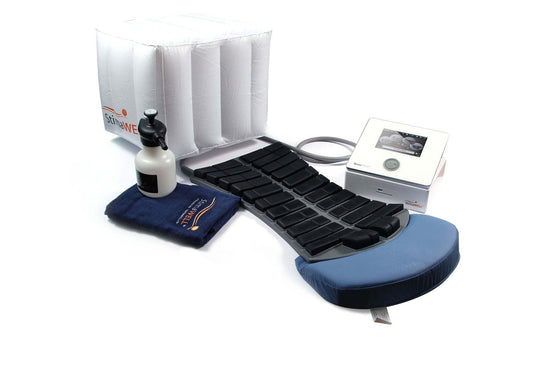
أبحاث الموجات الباعثة للضغط الدافق للهاتف الخلوي
-
ما هي القوة الدافعة الكهرومغناطيسية للهاتف المحمول؟
تنبعث من الهواتف الخلوية إشعاعات كهرومغناطيسية في المقام الأول كموجات ترددات لاسلكية (RF) لتسهيل الاتصال. تندرج موجات الترددات اللاسلكية هذه تحت الإشعاع غير المؤين، مما يعني أنها تفتقر إلى الطاقة اللازمة لكسر الروابط الكيميائية أو إتلاف الحمض النووي مباشرة. بالإضافة إلى ذلك، تنتج الهواتف موجات كهرومغناطيسية ذات تردد منخفض للغاية (ELF) بسبب مكوناتها الإلكترونية الداخلية.
-
كيف تتفاعل القوة الدافعة الكهرومغناطيسية مع الجسم
عند استخدام الهاتف الخلوي، تتفاعل موجاته الكهرومغناطيسية مع الأنسجة القريبة، وخاصةً في الرأس واليد. وفي حين أن موجات الترددات اللاسلكية تسبب في المقام الأول تأثيرات حرارية، مما يؤدي إلى زيادة طفيفة في درجة حرارة الأنسجة، إلا أن التأثيرات غير الحرارية مثل الإجهاد الخلوي وتعطل نشاط الدماغ والأضرار التأكسدية تخضع للدراسة على نطاق واسع.
-
خطر الإصابة بالسرطان وتكوين الأورام
يتمثل أحد الشواغل الرئيسية في أبحاث الترددات الكهرومغناطيسية للهاتف الخلوي في الصلة المحتملة بالسرطان، وخاصة أورام الدماغ مثل الأورام الدبقية والأورام العصبية السمعية. وقد بحثت دراسات واسعة النطاق، مثل دراسة Interphone Study والبرنامج الوطني لعلم السموم (NTP) على الحيوانات في هذه المخاطر. في حين لم تجد دراسة Interphone Study أي دليل قاطع على وجود ارتباط كبير، إلا أنها لاحظت زيادة طفيفة في خطر الإصابة بالأورام بين المستخدمين بكثرة. وبالمثل، كشفت دراسة البرنامج الوطني للسموم عن تكوّن الأورام في الفئران التي تعرضت لمستويات عالية من إشعاع الترددات اللاسلكية، على الرغم من أن صلتها بالتعرض البشري محل نقاش.
-
التأثيرات العصبية والإدراكية
استكشفت الدراسات كيف يمكن أن تؤثر الموجات الكهرومغناطيسية للهاتف الخلوي على الصحة العصبية، بما في ذلك الذاكرة والانتباه وأنماط النوم. ارتبط التعرض لفترات طويلة، خاصةً بالقرب من الرأس، بتغيرات في نشاط موجات الدماغ واضطراب دورات النوم. وفي حين أن بعض الأبحاث تربط بين الترددات الكهرومغناطيسية والتغيرات الإدراكية، يرى آخرون أن هذه التأثيرات طفيفة ومؤقتة.
-
التأثيرات على الخصوبة
درست الأبحاث أيضاً تأثير الترددات الكهرومغناطيسية للهاتف الخلوي على الصحة الإنجابية. على سبيل المثال، تشير الدراسات التي أجريت على خصوبة الذكور إلى أن حمل الهاتف في الجيب الأمامي أو استخدامه لفترات طويلة بالقرب من منطقة الحوض قد يقلل من عدد الحيوانات المنوية ويقلل من حركتها ويزيد من تفتت الحمض النووي. تؤكد هذه النتائج على أهمية وضع الهاتف وعادات الاستخدام.
-
مناقشة الجيل الخامس 5G
أدى إطلاق شبكات الجيل الخامس إلى ظهور ترددات كهرومغناطيسية عالية التردد، مما أثار مخاوف جديدة بشأن الآثار الصحية. وفي حين تعمل شبكات الجيل الخامس بترددات الموجات المليمترية، التي تخترق الأنسجة بعمق أقل، فإن تأثيرها البيولوجي على المدى الطويل لا يزال قيد التحقيق. لم تحدد الأبحاث الحالية مخاطر فريدة من نوعها من شبكات الجيل الخامس، ولكن الدراسات الجارية تهدف إلى توضيح مدى سلامتها.
-
استراتيجيات التخفيف من الآثار
للحد من المخاطر المحتملة، فكر في اعتماد تدابير عملية مثل:
- استخدام مكبر الصوت أو سماعات الرأس لإبقاء الجهاز بعيداً عن رأسك.
- الحد من مدة المكالمات والرسائل النصية عند الإمكان.
- تجنب حمل الهاتف مباشرة على جسمك، خاصة في الجيوب.
- إيقاف تشغيل الميزات اللاسلكية مثل Bluetooth وWi-Fi عندما لا تكون قيد الاستخدام.
-
الاتجاهات البحثية المستقبلية
ومع استمرار تطور تكنولوجيا الهواتف المحمولة، تزداد الحاجة إلى مواكبة الأبحاث لهذا التطور. فالدراسات طويلة الأجل ضرورية لفهم تأثيرات الكمون في حين أن هناك حاجة إلى مزيد من التركيز على التأثير البيولوجي للتقنيات الناشئة مثل الجيل الخامس وما بعده. سيكون البحث متعدد التخصصات، الذي يجمع بين علم الأوبئة وعلم الأحياء والفيزياء، أمرًا بالغ الأهمية للحصول على رؤى شاملة.
منتجات سيدونا للصحة والعافية
-
قناع الوجه سيدونا بيمف
بائع:سيدونا ويلنس4.75 / 5.0
(4) 4 إجمالي المراجعات
سعر عادي $390.00 USDسعرسعر الوحدة / لكل -
وسادة تيميز بيمف تيميز
بائع:سيدونا ويلنس4.67 / 5.0
(3) 3 إجمالي المراجعات
سعر عادي $390.00 USDسعرسعر الوحدة / لكل -
حصيرة سيدونا برو بيمف
بائع:سيدونا ويلنس5.0 / 5.0
(12) 12 إجمالي المراجعات
سعر عادي ابتداءا من 5,900.00 $ USDسعرسعر الوحدة / لكل -
حصيرة سيدونا برو بلس بيمف
بائع:سيدونا ويلنس5.0 / 5.0
(8) 8 إجمالي المراجعات
سعر عادي ابتداءا من 6,900.00 $ USDسعرسعر الوحدة / لكل -
حصيرة سيدونا إيليت بيمف
بائع:سيدونا ويلنس5.0 / 5.0
(20) 20 إجمالي المراجعات
سعر عادي ابتداءا من 7,900.00 $ USDسعرسعر الوحدة / لكل -
كرسي سيدونا PEMF
بائع:سيدونا ويلنسالسعر العادي ابتداءً من 15,900.00 دولار أمريكيالسعر العاديسعر الوحدة / لكل -
حصيرة الظهر STIMAWELL EMS
بائع:سيدونا ويلنسالسعر العادي 16,900.00 دولار أمريكيالسعر العاديسعر الوحدة / لكل -
سرير لونجفيتي لاونجيتي بيمف
بائع:سيدونا ويلنسالسعر العادي من $21,900.00 دولار أمريكيالسعر العاديسعر الوحدة / لكل

















